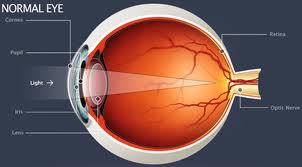How Do We See?
Light rays enter the eye through the cornea, pupil and lens. The cornea is the clear, round dome covering the iris, the colored ring in the center of the eye, and the pupil, the black circle in the middle of the iris. The light rays then pass through the vitreous, a clear, gel-like substance that fills the middle of the eye, and are focused on the retina, a light-sensitive tissue lining the back of the eye.

The macula is a very small area at the center of the retina that gives us our fine, pinpoint central vision. The area of retina surrounding the macula gives us our peripheral — or side — vision. The retina converts light rays into impulses that are sent through the optic nerve to your brain, where they are recognized as images.
By helping to focus light as it enters the eye, the cornea and the lens both play important roles in giving us clear vision. In fact, 70% of the eye's focusing power comes from the cornea and 30% from the lens.
What Is a Refractive Error?
In the normal, healthy eye, the cornea is clear, smooth and round and the lens is clear, allowing light rays to pass through unobstructed and be focused sharply on the retina. However, if the cornea is not as smooth, clear or round as it should be, or the eyeball is too long or too short, light rays will bend (or refract) at odd angles, leading to blurry or distorted vision. This inability to achieve sharp focus is called refractive error, and is the most common eye problem. Refractive errors include nearsightedness, or myopia; farsightedness, or hyperopia; or astigmatism.
Similarly, the eye will have focusing problems if the naturally clear lens isn’t as flexible as it should be, causing presbyopia.
There are several alternatives for correcting your vision:
- Eyeglasses
- Contact lens
- LASIK and other refractive surgery
- Orthokeratology
